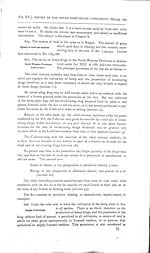Medicine - Drugs > Report of the Indian Hemp Drugs Commission, 1894-1895 > Volume I
(330) Page 296
Download files
Individual page:
Thumbnail gallery: Grid view | List view

296 REPORT OF THE INDIAN HEMP DRUGS COMMISSION, 1893-94. [CH. XV.
except in the case of
charas, half the duty on which is levied at the time of
taking
out the pass for the importation of the drug.
The importance of the
ganja traffic in Bengal may be gathered from the
fact that in the year 1892-93 1,510 maunds were exported to other
provinces and
5,451 maunds paid duty, amounting to Rs. 12,80,631. The license
fees for retail
sale of ganja amounted to Rs. 11,05,435 in addition. The total
revenue from
charas, of which only 11 maunds 26 sérs paid duty, was Rs. 9,097,
and from
bhang, of which 1,033 maunds paid duty, Rs. 53,558.
Assam.
Law in force.
602. The law in force in
Assam is the same as in Bengal, and the Bengal
Excise Manual is
followed.
Supply of the drugs.
603. There is no licensed
cultivation of hemp for the production of
the drugs. Excise ganja is
supplied from Bengal
under pass, and pays duty in the province. The
vend of charas and bhang is practically forbidden, as no licenses
for
their sale have been taken out. Wild hemp grows spontaneously
in
many parts of the province, and especially in the hill tracts. The
offi-
ciating Excise Commissioner says: "There is nothing to show that
the
trade in the wild plant is sufficiently large to compete seriously
with excise
ganja, unless possibly in the Khasi Hills, where the continuous
decrease in
the consumption of the Rajshahi drug can, I think, only be
attributed to
the cheapness of wild hemp and the great facilities for its use.
The excise
administration of the district is attended by abnormal difficulties
owing to
the fact that the Khasi Hills are parcelled out into the
territories of many
semi-independent chiefs. The wild plant is used by habitual
consumers
only as a pis aller, and when their supply of the excise
ganja runs short."
This view is not shared by the Excise Commissioner, Mr. Driberg,
who says: "I
think this so-called wild hemp affects our
revenue very considerably. It is used
by certain consumers, and is also mixed by vendors with excise
ganja and sold."
Mr. Driberg states that he does not think there is any such thing
as wild ganja.
As a rule the plant is found in lands occupied by the owner's
homestead. From
this he infers that the growth is very ordinarily surreptitious. He
thinks that the
practice of Deputy Commissioners in treating this growth as
unlicensed cultivation
differs considerably. A circular issued by the Chief Commissioner
in October 1882
contains a ruling which appears to be the cause of this diversity
of practice.
The concluding portion runs as follows: "You will observe that in
rule 2, section
17, of Chapter XV, of the Board's Rules it is said that 'no
restriction is imposed
on the use of the hemp plant in its green state for medical or
other purposes,
or on its manipulation for the manufacture of fibre. But any
preparation of the
plant to be used, stored, and sold as a narcotic or stimulant is
prohibited except
under the rules framed by the administration.' This rule mentions
the medicinal use
of the plant only 'in its green state;' but if, as appears to be
the case, the wild
hemp is also used for medicine for cattle when dried, the Chief
Commissioner
desires that the rule may be liberally interpreted, and no penalty
imposed when
it is probable that the cultivation or the drying and storing of it
was only for this
purpose. Whether this is so or not is a question of fact." Mr.
Driberg, whose
experience of Assam is unique, does not believe that the plant is
used to any
Set display mode to: Large image | Zoom image | Transcription
Images and transcriptions on this page, including medium image downloads, may be used under the Creative Commons Attribution 4.0 International Licence unless otherwise stated. ![]()
| India Papers > Medicine - Drugs > Report of the Indian Hemp Drugs Commission, 1894-1895 > Volume I > (330) Page 296 |
|---|
| Permanent URL | https://digital.nls.uk/74574726 |
|---|---|
| Description | Chapter XV, cont. |
| Description | [Volume 1]: Report. |
|---|---|
| Attribution and copyright: |
|




